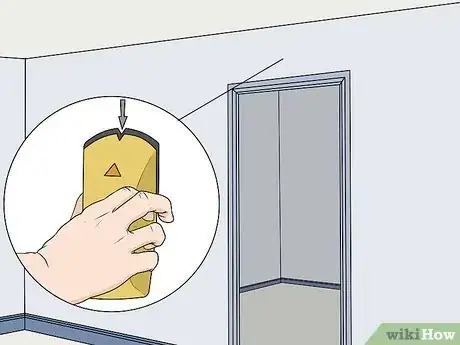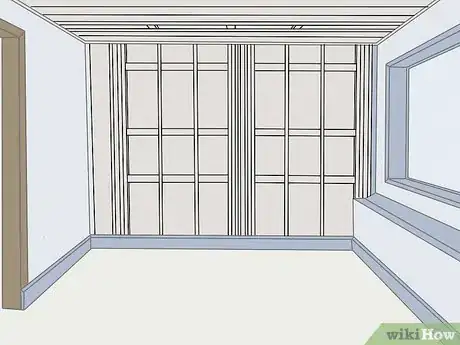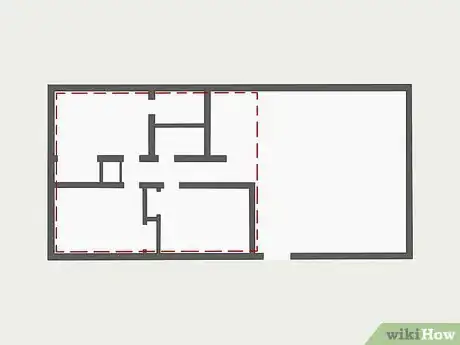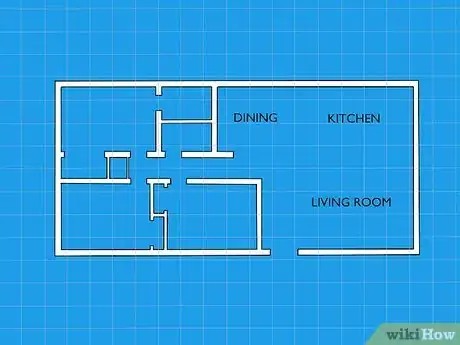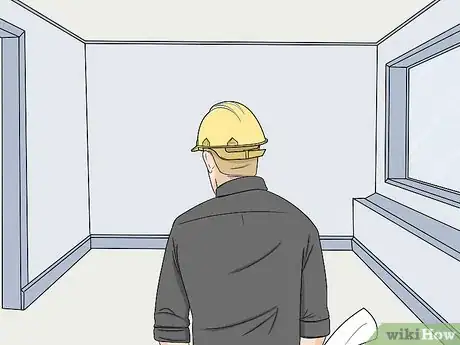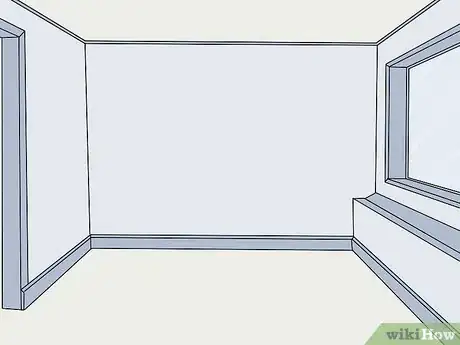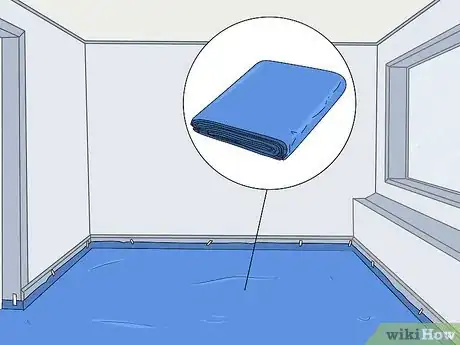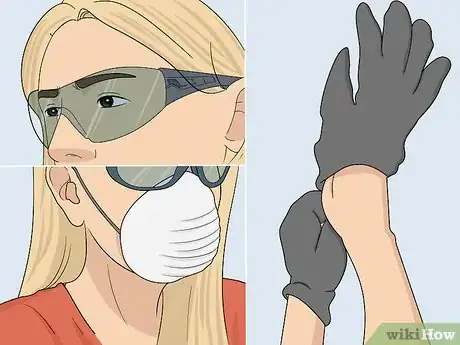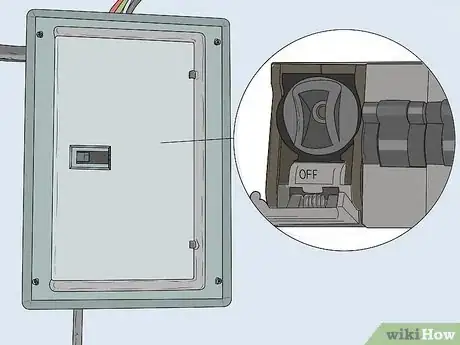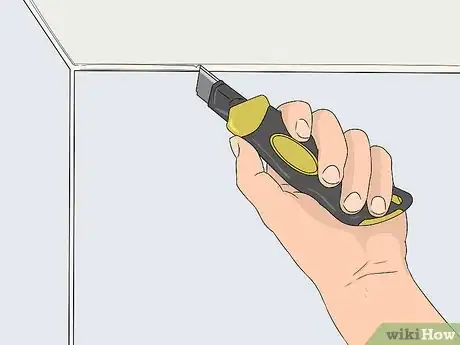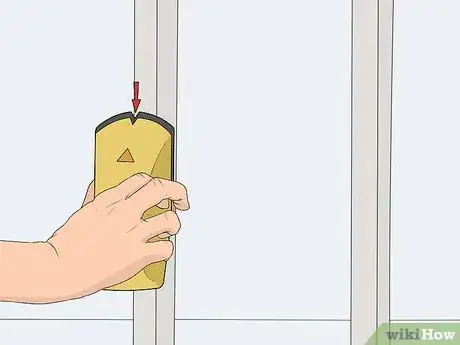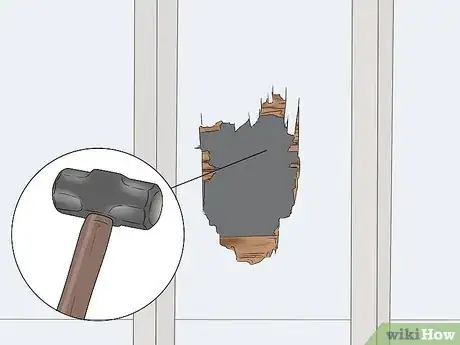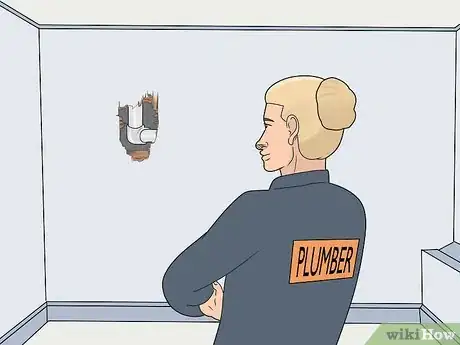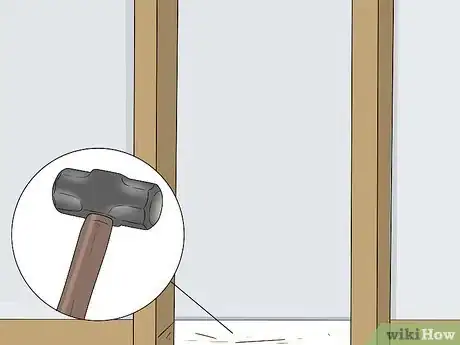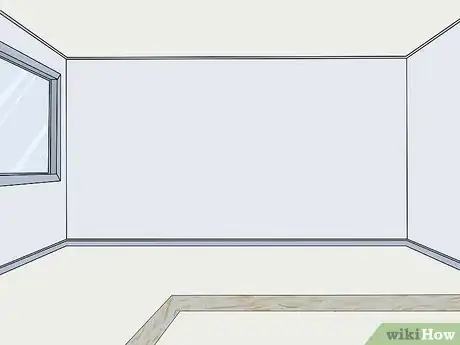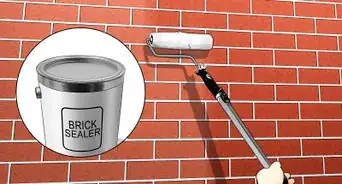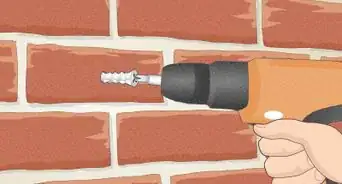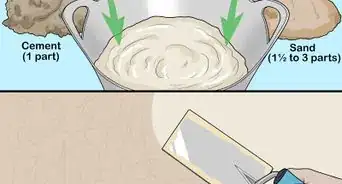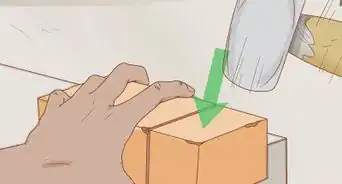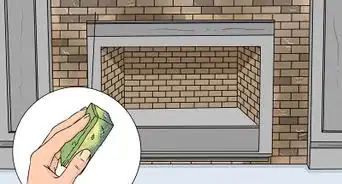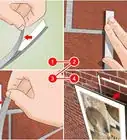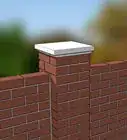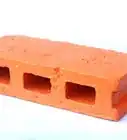This article was co-authored by Kevin Schlosser. Kevin Schlosser is a Home Improvement Specialist and the Owner of Home Tech Handyman Ltd. With over 20 years of experience, Kevin specializes in age-in-place installations, flooring, roofing, and general remodeling handyman services. Kevin holds a blend of construction and in-home technology-related certifications including NAHB Certified Age-in-Place Specialist, CEDIA membership and certifications, and a Certification from the Association of Certified Handyman Professionals. Also, he is in training to receive certifications in Construction, Project Management, and other CEDIA qualified system integrator certifications. He is fully-insured in the state of Colorado.
There are 10 references cited in this article, which can be found at the bottom of the page.
This article has been viewed 144,641 times.
Taking down a standard wall consisting of drywall and wall studs can open up a room and create a lot more space. You can knock down a wall yourself, but you need to first make sure that the wall isn’t load-bearing.[1] If it isn’t, clear the room on both sides of the wall and cover the floors, vents, and the entranceways so you can contain the dust, dirt, and debris. Use a sledgehammer to create holes in the drywall so you can remove it. Then, remove the studs by bashing them with the sledgehammer. Always wear safety glasses, a face mask, and gloves for protection.
Steps
Determining If a Wall Is Load-Bearing
-
1Identify load-bearing walls by solid headers above the doorways. A header is a solid section of wood that is installed over a doorway on a load-bearing wall in order to redistribute the weight and compensate for the studs that were removed to widen the opening to install the doorway. Use a stud finder to see if the space above your door is a solid header.[2]
- Look for a solid section of wood that would indicate a header was installed and the wall is load-bearing.
- If the space above a doorway on the wall is hollow, then it’s likely not a load-bearing wall.
-
2Note that stacked walls are structural and shouldn't be removed. Check the beneath the wall to see if it’s stacked on another wall. Go to the first floor, basement, pilings, or crawlspace and look to see if there are piers or girders underneath the wall that would indicate that it is a load-bearing wall. If there is, then it is likely a load-bearing wall.[3]
- If the wall you plan to knock down is on the second floor, check to see if there’s a wall in the exact same place on the floor below it.
- Piers or girders look like solid metal beams and are used to support structures. If you see them below your wall, then it means the wall also supports the weight of the building.
- If you see pylons, which look like large posts, beneath your wall, it means your wall is load-bearing.
- Be careful crawling beneath the structure to inspect the walls.
Advertisement -
3See if the wall runs parallel to the frame for signs that it’s load-bearing. If the wall runs through the center of the building and is beneath the trusses or frame of the structure, then it may be a load-bearing wall. Just because the wall runs parallel to the framing above it doesn’t necessarily mean that it’s load-bearing, but it is a sign that it could be and it needs to be confirmed before you try to knock it down.[4]
- If you see ceiling or floor joists at the edges of the wall, then it’s definitely a load-bearing wall.
-
4Review the blueprints to confirm if the wall is structural. If you have the original blueprints of the building, there should be a key that includes markings to indicate which walls are load-bearing. Look for an “S” which means “Structural” near walls, joists, and other features on the blueprint. Look for the wall you plan to knock down and determine whether it’s structural or not.[5]
- Read the blueprints closely to look for indicators that a wall is load-bearing. Use the key to identify structural features.
-
5Have the wall inspected by a structural engineer to be sure. The best way to determine that a wall isn’t load-bearing is to hire a structural engineer to come out and inspect it. They’ll be able to analyze the structure and confirm whether or not it’s safe for you to knock down the wall.[6]
- Look online for structural engineers or engineering firms you can pay to inspect your wall.
- Hiring a structural engineer can cost between $300-$500.[7]
Protecting the Rooms
-
1Clear the rooms on both sides of the wall. Take out any furniture, rugs, decor, and anything else from the room so they’re not in the way and they don’t get any dust or dirt on them. Make sure the rooms on both sides of the wall are completely empty.[8]
- Be sure to take down anything that may be hanging on the wall as well.
-
2Lay down a plastic tarp over the floor to protect it. Once the rooms are clear, put down enough plastic tarp to cover all of the floors and baseboards so they’re protected from any dust, dirt, and debris that may get on them from the wall being knocked down. Use masking tape to seal the edges of the tarp and connect them to the other walls.[9]
- You can also use plastic drop cloths, but make sure there aren’t any gaps between them.
- Find tarps and drop cloths at home improvement stores, paint supply stores, and online.
-
3Hang plastic sheeting in the doorways to block off the room. Taking down the wall can release a lot of dust and dirt in the air, which can escape into adjacent rooms through the doorways. Use masking tape to hang plastic sheets over the entrances so the room is sealed and dust is contained inside of it.[10]
- Tape the sheets to the top of the doorways so they hang down over the opening.
-
4Cover any vents in the rooms to keep dust from escaping. Place towels or plastic sheets over the air vents in the room so dust isn’t distributed to the other rooms in the building. Use masking tape to seal the edges of the vents.[11]
- Keep any ceiling fans turned off to minimize the dust being shifted around.
Tip: Turn off the air conditioning if you can to reduce the amount of dust that’s sucked into the system.
Removing the Wall
-
1Put on gloves, safety glasses, and a face mask to protect yourself. Knocking down a wall will produce lots of dust and dirt that you don’t want to breathe in or get into your eyes. Put on safety glasses and a face mask for safety. You’ll also want to protect your hands by wearing a sturdy pair of work gloves.[12]
- You can find work gloves, safety glasses, and face masks at home improvement stores, at department stores, and online.
-
2Shut off power to the room before you start working. Flip the breaker that controls electricity to the room so you can knock down the wall without the risk of shocking yourself. Even if you don’t see electrical outlets on the wall, then you need to make sure there isn’t a live current before you begin working.[13]
- Plug in an electrical device and try to turn it on to test that the outlets are off.
- Test that the power to the room has been shut off by flipping the light switches on and off.
-
3Score the paint and caulk where the wall meets the ceiling. Use a utility knife or a sharp knife to cut a line along where the wall meets the ceiling to make it easier to knock down the wall. Make sure the cut is deep and penetrates the paint and caulk that connects the wall and ceiling together.[14]
- Scoring the ceiling will help prevent the wall you’re knocking down from pulling down the ceiling.
-
4Locate 2 studs so you can hammer between them. Use a stud finder or tap against the wall lightly against the wall and listen for a hollow or solid sound that indicates that a stud is located there. Then, locate the stud adjacent to it so you can avoid striking them when you start to break up the drywall.[15]
- Use a flashlight to help you see inside of the wall.
- Mark the location of the studs on the drywall using a pen, pencil, or marker.
-
5Make a small hole in the drywall between the studs with a sledgehammer. Strike the wall with a sledgehammer to make a hole in it. 1 small hole is all you need in order to check for wiring and pipes in the wall before you start pulling off the drywall. If you strike a wall stud, aim your next blow to the side of where you hit so you can strike the drywall.[16]
- It will be much easier to remove the studs once you take down all of the drywall.
Warning: Be very careful when you’re swinging a sledgehammer. Always check to make sure the area is clear of any other people before you swing..
-
6Look for plumbing and wiring and hire a professional if there are any. When you make a hole with your sledgehammer, look inside and try to identify any plumbing or electrical lines that may be running through the wall. If you do have any active electrical wiring or plumbing running through the wall, you need to hire a plumber or an electrician to remove them properly.[17]
- A plumber can cost between $45-$150 an hour. Look online for local plumbers you can hire.
- You can hire an electrician for about $50-$100 an hour. The total cost will depend on how extensive the required work is to remove the wiring.
-
7Create additional holes and use your hands to pull off the drywall. Add more small holes in the drywall between wall studs with the sledgehammer. Grip the edges of the holes with your hands, pull off pieces of the drywall and dispose of them. Continue making holes and pulling off the drywall until it’s all gone.[18]
- Use the sledgehammer to break up the drywall to make it easier to remove by hand.
- Remove all of the drywall on 1 side of the wall, then repeat the process on the other side of the wall.
-
8Bash the studs out of the way with the sledgehammer. Once the drywall is out of the way, use the sledgehammer to strike the studs and break them up into pieces. Pick up the pieces as you remove them and place them into the trash. Continue breaking the studs into pieces and removing them until the entire wall is gone.[19]
- Strike the studs from the side to break them into pieces.
- Use a pry bar to pull the stud out of the wall if necessary.
-
9Clean up the debris, turn on the power, and replace the items in the room. When the wall has been completely knocked down, use a broom and duster to sweep up the dust, dirt, and debris from the floor and walls. Pick up the plastic sheets and dispose of the debris in the garbage. Flip the breaker to restore power to the room and then move the furniture, decor, and other objects back into the room.[20]
- Remove any masking tape, hanging plastic sheets, or anything else you used to protect the room.
Expert Q&A
Did you know you can get expert answers for this article?
Unlock expert answers by supporting wikiHow
-
QuestionHow can I make sure I'm doing this safely and not going to damage my home?
 Kevin SchlosserKevin Schlosser is a Home Improvement Specialist and the Owner of Home Tech Handyman Ltd. With over 20 years of experience, Kevin specializes in age-in-place installations, flooring, roofing, and general remodeling handyman services. Kevin holds a blend of construction and in-home technology-related certifications including NAHB Certified Age-in-Place Specialist, CEDIA membership and certifications, and a Certification from the Association of Certified Handyman Professionals. Also, he is in training to receive certifications in Construction, Project Management, and other CEDIA qualified system integrator certifications. He is fully-insured in the state of Colorado.
Kevin SchlosserKevin Schlosser is a Home Improvement Specialist and the Owner of Home Tech Handyman Ltd. With over 20 years of experience, Kevin specializes in age-in-place installations, flooring, roofing, and general remodeling handyman services. Kevin holds a blend of construction and in-home technology-related certifications including NAHB Certified Age-in-Place Specialist, CEDIA membership and certifications, and a Certification from the Association of Certified Handyman Professionals. Also, he is in training to receive certifications in Construction, Project Management, and other CEDIA qualified system integrator certifications. He is fully-insured in the state of Colorado.
Home Improvement Specialist Before you get started it's very important to investigate to determine if the wall you want to knock out is load-bearing. It's also a good idea to remove each part of the wall individually instead of knocking it all down at once. That ensures the safest removal since it reveals many of the inside parts such as electrical, plumbing, or HVAC that you could potentially damage inside the wall and that need to be moved or mitigated in some way.
Before you get started it's very important to investigate to determine if the wall you want to knock out is load-bearing. It's also a good idea to remove each part of the wall individually instead of knocking it all down at once. That ensures the safest removal since it reveals many of the inside parts such as electrical, plumbing, or HVAC that you could potentially damage inside the wall and that need to be moved or mitigated in some way. -
QuestionIf I take the studs out, will the house collapse?
 John822Community AnswerIf you take the studs out of a load bearing wall, the house will collapse if you don't put in temporary supports. If it is not a load-bearing wall, then you can safely remove studs. Consult your house's blueprints or a builder to see if your wall is load-bearing or not.
John822Community AnswerIf you take the studs out of a load bearing wall, the house will collapse if you don't put in temporary supports. If it is not a load-bearing wall, then you can safely remove studs. Consult your house's blueprints or a builder to see if your wall is load-bearing or not. -
QuestionWhy is water sprayed on demolished buildings?
 Community AnswerWhen a building is demolished, the debris is unstable. Spraying water on the building dampens the dust particles so they will stick to surfaces, rather than being blown into the air by wind, vibrations, or falling, and therefore, prevents atmosphere pollution.
Community AnswerWhen a building is demolished, the debris is unstable. Spraying water on the building dampens the dust particles so they will stick to surfaces, rather than being blown into the air by wind, vibrations, or falling, and therefore, prevents atmosphere pollution.
Warnings
- Wear work gloves, safety glasses, and a face mask when you’re knocking down a wall.⧼thumbs_response⧽
- Always check your surroundings before you swing a sledgehammer.⧼thumbs_response⧽
Things You’ll Need
- Plastic tarp
- Masking tape
- Utility knife
- Sledgehammer
- Work gloves, safety glasses, and face mask
- Pry bar (optional)
- Stud finder (optional)
References
- ↑ Kevin Schlosser. Home Improvement Specialist. Expert Interview. 19 February 2021.
- ↑ https://medium.com/@preppycarpenter/5-ways-to-identify-a-load-bearing-wall-de8af28d94cb
- ↑ https://medium.com/@preppycarpenter/5-ways-to-identify-a-load-bearing-wall-de8af28d94cb
- ↑ https://cottagelife.com/design-diy/how-to-tell-if-a-wall-is-load-bearing/
- ↑ https://www.thisoldhouse.com/ideas/how-to-take-down-wall
- ↑ https://medium.com/@preppycarpenter/5-ways-to-identify-a-load-bearing-wall-de8af28d94cb
- ↑ https://www.homeadvisor.com/cost/architects-and-engineers/hire-an-engineer/#:~:targetText=Engineer%20Rates,of%20your%20total%20project%20cost.
- ↑ https://www.homebuilding.co.uk/knocking-down-internal-walls/
- ↑ https://www.popularmechanics.com/home/interior-projects/how-to/g2487/5-things-to-beware-of-before-demolishing-a-wall/
- ↑ https://www.thisoldhouse.com/ideas/how-to-take-down-wall
- ↑ https://www.washingtonpost.com/news/where-we-live/wp/2015/09/15/what-you-need-to-know-before-knocking-down-that-wall-in-your-home/
- ↑ https://www.popularmechanics.com/home/interior-projects/how-to/g2487/5-things-to-beware-of-before-demolishing-a-wall/
- ↑ https://www.popularmechanics.com/home/interior-projects/how-to/g2487/5-things-to-beware-of-before-demolishing-a-wall/
- ↑ https://www.popularmechanics.com/home/interior-projects/how-to/g2487/5-things-to-beware-of-before-demolishing-a-wall/
- ↑ https://www.homebuilding.co.uk/knocking-down-internal-walls/
- ↑ https://www.homebuilding.co.uk/knocking-down-internal-walls/
- ↑ https://www.homeadvisor.com/cost/additions-and-remodels/remove-load-bearing-wall/
- ↑ https://www.homebuilding.co.uk/knocking-down-internal-walls/
- ↑ https://youtu.be/zjtI-sHUsoA?t=312
- ↑ https://www.homebuilding.co.uk/knocking-down-internal-walls/
About This Article
It’s important to knock down a wall the right way so you don’t cause unnecessary damage to your house. You’ll need to make sure the wall’s not load-bearing, or you’ll risk the roof or ceiling coming down. You’ll also need to make sure there’s no plumbing or electrical wiring going through the wall. You can do this by making small holes in the plasterboard and looking inside the wall. If there is plumbing or electrical lines in the wall, hire a plumber or electrician to remove them. If the wall’s clear, you can knock more holes through the wall with a sledgehammer and pull off the drywall with your hands. It’s best to do this one side of the wall at a time. Just make sure to wear gloves, a mask, and safety glasses to protect yourself from dust and debris. For more tips, including how to protect the rooms in your house before knocking down a wall, read on!

